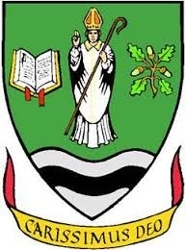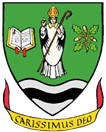About St Kentigern

Like all Catholic schools our school is dedicated to a saint - in this case St Kentigern.
We owe our knowledge of St Kentigern's life to French monks in the Abbey of Kelso who wrote an account for the Bishop of Glasgow in the twelfth century. The complete work of Jocelyn, one of these monks, is in the British Museum. His source would be oral tradition, but oral tradition is in fact our source for most of the history of the period. No doubt facts had become liberally encrusted with legend, but where comparisons can be made with other sources, for example Bede's History of England and Anglo-Saxon and Welsh King lists, Jocelyn's account is accurate.
Who was Kentigern?
Kentigern was born in 518. He was the son of Tannoch, a princess of Lothian, who has given her name to St Enoch's Square in Glasgow, and to Tannochside near Uddingston. Tannoch's father was a pagan and when she adopted Christianity she was expelled from her home. During her wanderings she was raped, and her father ordered that she be set adrift in an open boat at Aberlady in order that her pregnancy should not bring a slur on the family name. The boat was washed upon the shore at the Christian settlement of Culross and there the infant Kentigern was born. He was christened Kendyern, British for "Great Chief'. (The British form indicates that the 'g' should be soft. The hard 'g' perhaps arises from the fact that Jocelyn wrote in Latin). But within the community he was often referred to by the pet name of Myncho, which has become Mungo, and means "little dear". It is by this name that he is known as the patron saint of Glasgow.
Having been ordained priest, Kentigern set out to restore the faith at Glasgow. He crossed the Forth at Alloa and set up his church on the Molendinar Burn, where Glasgow Cathedral now stands at the top of the High Street. He was greatly aided in his work of conversion by the local chieftain Rederich, whose fortress was Dumbarton, the fort of the Britons. Rederich brought over a Bishop from Ireland to consecrate the 25-year-old Kentigern first bishop of Glasgow.
Trouble from the pagans led to the flight of Rederich and Kentigern to the South. They stopped for a short time near Penrith and established a settlement at Crossfield. After a brief sojourn there, Kentigern travelled to Wales where he founded a monastery in the Vale of Ciwyd. Meanwhile Rederich and allies had defeated the pagans near Carlisle and Kentigern was able to return to Scotland in 573.
He stopped at Hoddam, by Dumfries, and established missions throughout Galloway, which had been converted 150 years earlier by St Ninian.
After eight years Kentigern returned to Glasgow, where he died in January 603. In 1197, probably as a result of Jocelyn's writings, a church was built over the tomb, and his church was the beginnings of the present Glasgow Cathedral. In Glasgow he was known better by his pet name of Mungo, but dedications to St Kentigern are common throughout the South of Scotland, in the North of England, and in Wales.
Jocelyn's account informs us that Kentigern met many other saints -St Serf at Culross, Saints David and Asaph in Wales, St Columba in Glasgow. He also paid several visits to Rome, on the last of which the Pope gave Glasgow the title "Special Daughter of the Church".
St Kentigern was chosen as our patron firstly because of his connection with the old Kingdom of Lothian, his grandfather being Loth who ruled from the fort on Traprain Law near Haddington; and secondly because so many of the students here have Glasgow origins.
The School and its Badge
Our school badge shows the saint, with on his right the Book of Knowledge and on his left an oak spray, representing both West Lothian and Glasgow.
The wavy black line on a white background represents the Black Burn.
Our school motto is 'Carissimus Deo" meaning "Dearest to God"
The school was built in 1973 and refurbished in 1995/6. An extensive refurbishment of the school was completed in September 2009.




